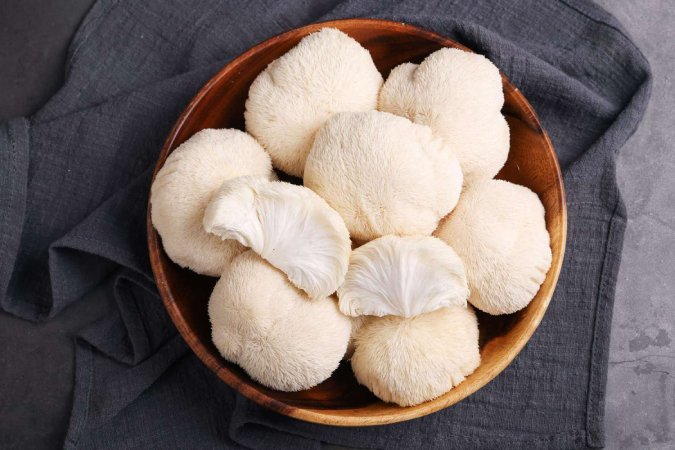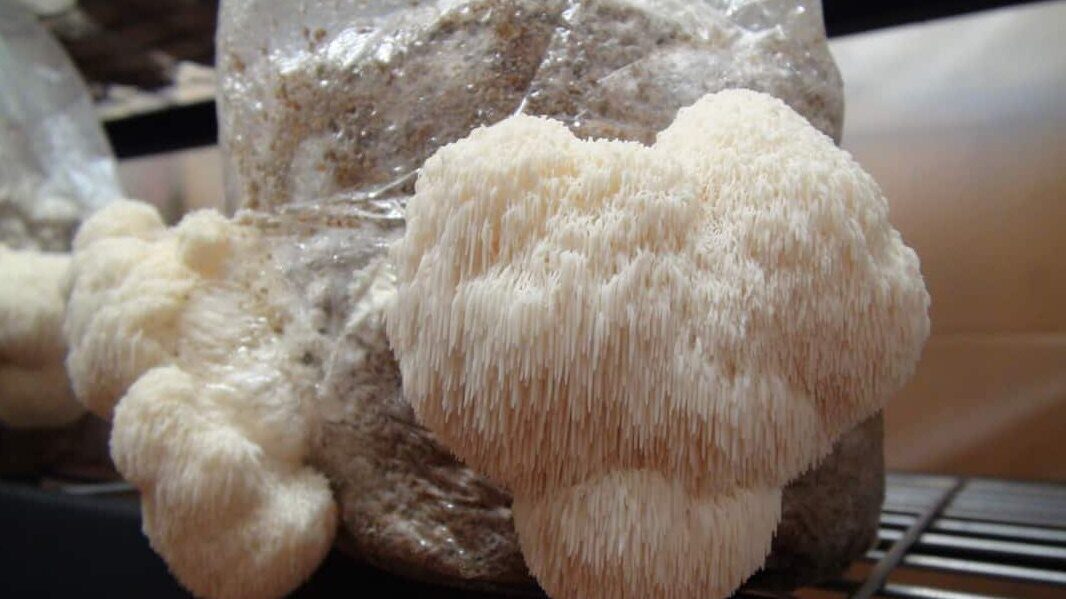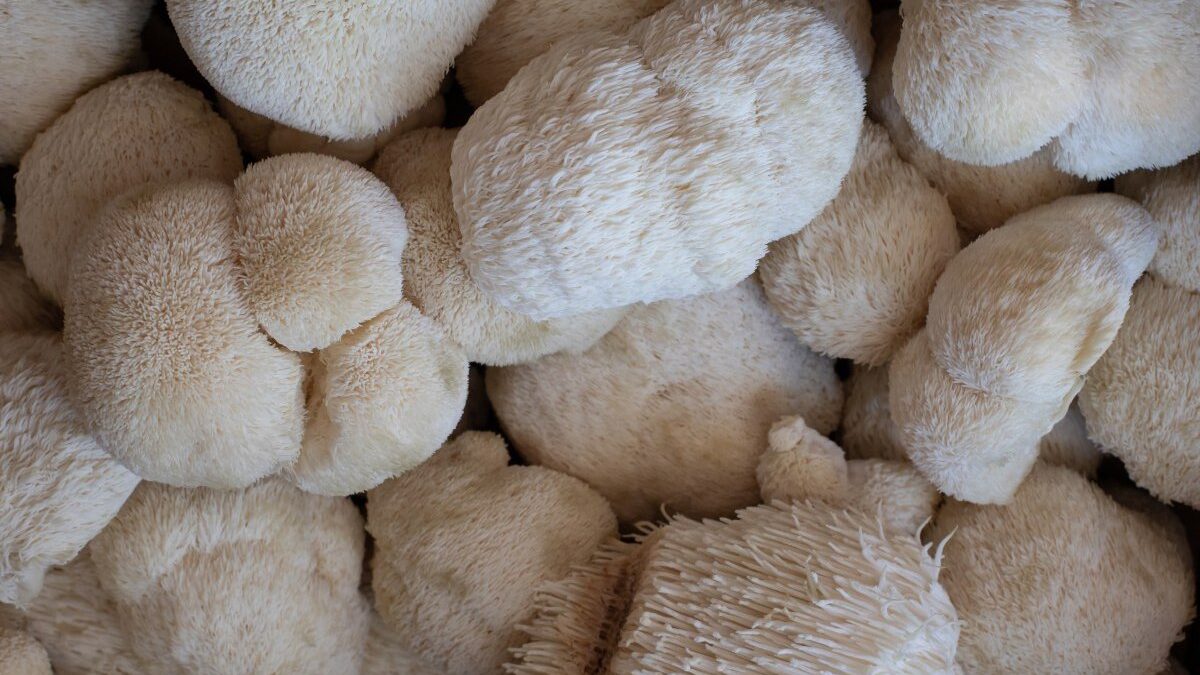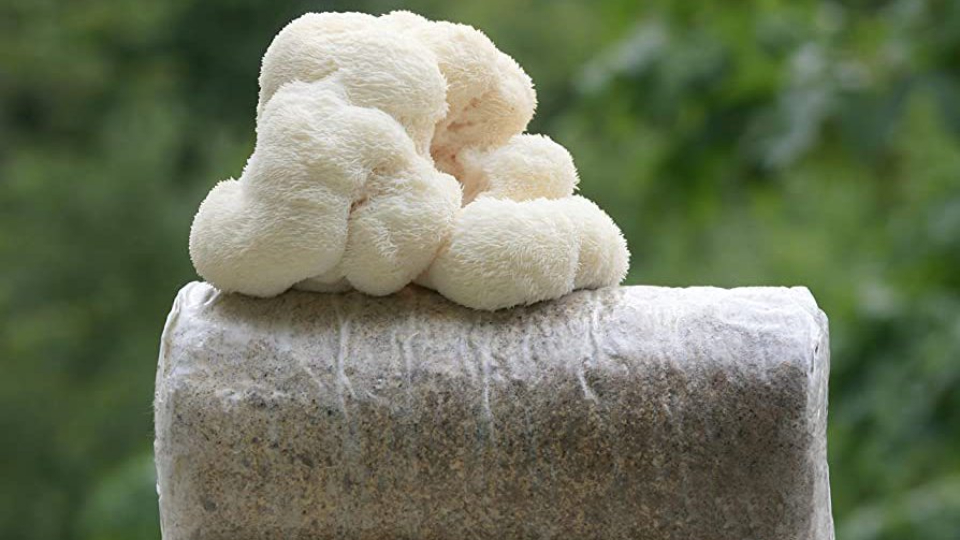Growing Lion’s Mane Indoors and Outdoors (A Step-by-Step Guide)
Learn how to grow Lion’s Mane mushrooms and explore their distinct taste and potential health benefits. There are various ways to cultivate this edible fungus, both indoors and outdoors, depending on your preferences and available resources as a fungi enthusiast.
First, choose the best method for you, such as growing on logs, using sawdust or straw, or liquid culture or grain spawn. Then, follow our step-by-step instructions on substrate selection, spore inoculation, and maintaining optimal growing conditions.
In addition, we will provide valuable tips on how to troubleshoot issues that may arise during the cultivation process. With our comprehensive guide, you can confidently grow your own Lion’s Mane mushrooms and savor their delectable flavor.
In this article:
What is Lion’s Mane Mushroom?
Lion’s Mane Mushroom, also known as Hericium erinaceus or Monkey Head Mushroom, in Chinese Known as Hou Tou Gu (猴头菇), is a unique edible fungus that has gained popularity in recent years due to its potential health benefits. This mushroom is native to North America, Europe, and Asia and is known for its distinctive appearance, which resembles a lion’s mane.
Lion’s Mane Mushroom has a long history of use in traditional medicine for its potential cognitive and neurological benefits. It contains compounds that may stimulate nerve growth and promote the production of brain-derived neurotrophic factor (BDNF), a protein that is essential for the growth and survival of neurons. This makes it a promising potential treatment for conditions such as Alzheimer’s and Parkinson’s disease.
In addition to its potential health benefits, Lion’s Mane Mushroom is also a delicious ingredient in many recipes. Its delicate, seafood-like flavor and unique texture make it a popular choice for vegetarian and vegan dishes.
Health Benefits

Lion’s Mane mushrooms offer several potential health benefits that have made them increasingly popular in recent years. Studies have shown that they may have neuroprotective effects, promoting nerve growth and reducing inflammation in the brain. This can potentially help with cognitive function, memory, and mood disorders[1].
Additionally, Lion’s Mane mushrooms contain beta-glucans, a type of polysaccharide that has been linked to immune-boosting properties. They also contain antioxidants, which can help protect cells from damage caused by free radicals.
Moreover, it has a long-standing history of use in Traditional Chinese Medicine, where it has been utilized to alleviate digestive issues, depression and anxiety[2], and exhaustion.
Other potential health benefits of Lion’s Mane mushrooms include their ability to lower cholesterol levels, reduce the risk of certain cancers, and improve digestive health. While more research is needed to fully understand the extent of these benefits, adding Lion’s Mane mushrooms to your diet can be a tasty and potentially beneficial choice.
According to mycologist Dr. Paul Stamets, “Lion’s Mane mushrooms are a treasure trove of health benefits, with the potential to improve brain function, promote nerve regeneration, and boost the immune system[3].”
Why Grow Lion’s Mane?
Growing Lion’s Mane mushrooms has several advantages, one of which is their potential health benefits. They contain compounds that may help to improve cognitive function, support the nervous system, and boost the immune system. Furthermore, they are a tasty, low-calorie, high-protein food, making them an excellent addition to any diet.
Apart from their potential health benefits, growing Lion’s Mane mushrooms can also be a fun and rewarding hobby. It allows individuals to connect with nature and provides a sense of accomplishment in producing their own food. So, whether you want to grow them for their taste or health benefits, or just as a hobby, Lion’s Mane mushrooms are a great addition to any garden or home.
There are several reasons why you might want to consider growing Lion’s Mane Mushrooms:
- Nutritious and tasty. They have a delicate, seafood-like flavor and a meaty texture that makes them an excellent meat substitute in vegetarian and vegan dishes.
- Rich in polysaccharides and other bioactive compounds that have been shown to have potential health benefits. These compounds are thought to support brain function, boost the immune system, and reduce inflammation.
- Easy to grow, and you can cultivate them indoors or outdoors. You don’t need a lot of space, and you can grow them in a variety of growing mediums, including straw, logs, or sawdust.
How to Grow Lion’s Mane Mushrooms?
Growing Lion’s Mane mushrooms can be a delightful and fulfilling experience for those interested in the fascinating world of mycology and cultivating their own food. Lion’s Mane mushrooms have a distinctive appearance and potential health benefits that make them increasingly popular as both a culinary and medicinal mushroom.
There are multiple techniques for cultivating Lion’s Mane mushrooms, each with its own advantages and disadvantages. These techniques include inoculating substrates with spores or mycelium, using a growing kit, liquid culture, logs, straw, or sawdust. Indoor methods typically involve growing mushrooms in a controlled environment, while outdoor methods rely on natural conditions and resources.
To grow Lion’s Mane mushrooms, it’s essential to provide the right growing conditions, such as a suitable substrate, adequate moisture, proper temperature, and sufficient air circulation. Additionally, careful attention must be paid to sanitation to avoid contamination by unwanted fungi or bacteria.
Grow Indoors
Lion’s Mane is a delicious and unique edible mushroom that can be grown indoors using various methods. To ensure successful growth, it’s essential to maintain the right humidity, temperature, and ventilation. The substrate should be kept moist, but not wet. It should also be exposed to indirect sunlight or fluorescent light for 12-16 hours per day.
“Lion’s Mane grows best in temperatures of 55-60 degrees Fahrenheit, with high humidity and good air circulation” (Rogers, 2018)[4].
Next, we’ll discuss the multiple methods and specific procedures involved in growing Lion’s Mane mushrooms indoors.
Method 1: Growing Lion’s Mane Mushrooms with a Growing Kit
Lion’s Mane Growing Kits are an easy way to start growing Lion’s Mane Mushrooms. They come with everything you need to start growing, including a bag of sterilized substrate, a bag of Lion’s Mane mycelium and other organic materials that are already inoculated with mushroom spores.All you need to do is follow the instructions that come with the kit, and you can have fresh Lion’s Mane Mushrooms in just a few weeks.
Materials:
- Lion’s Mane mushroom grow kit
- Water spray bottle
- Spray bottle filled with rubbing alcohol
- Clean work surface
- Latex gloves (optional)
Steps:
- Choose a clean and well-ventilated area to set up your grow kit. Avoid placing it in direct sunlight or near heat sources.
- Clean your work surface with rubbing alcohol to ensure it’s free from any contaminants.
- Put on latex gloves (optional) to prevent any contamination from your hands.
- Carefully remove the grow kit from its packaging and check for any signs of damage or contamination.
- Open the kit and take out the plastic bag containing the growing substrate and mushroom spores.
- Use the water spray bottle to moisten the growing substrate until it’s thoroughly damp but not dripping wet.
- Spread the mushroom spores evenly on top of the growing substrate, using the enclosed instruction as a guide for the amount of spores to use.
- Cover the growing substrate and spores with the enclosed humidity tent, making sure it’s fully sealed.
- Place the grow kit in a location that receives indirect light and a consistent temperature of around 65-75°F.
- Mist the inside of the humidity tent daily with the water spray bottle to maintain high humidity levels.
- Check on the grow kit regularly and remove any excess moisture or condensation that may have accumulated inside the humidity tent.
- After about 2-3 weeks, small white mushrooms will start to form on top of the growing substrate. These will eventually develop into mature Lion’s Mane mushrooms.
- Harvest the mushrooms by gently twisting and pulling them from the growing substrate. Rinse them under cold water to remove any debris and pat them dry with a paper towel.
- Store the harvested mushrooms in a paper bag in the refrigerator until you’re ready to use them.

Method 2: Growing Lion’s Mane Mushrooms with Grain Spawn
Materials:
- Pressure cooker
- Quart jars with lids and bands
- Rye grain or another suitable grain for spawn
- Lion’s Mane mushroom spawn
- Large plastic tub or grow bag
- Pasteurized straw or hardwood sawdust
- Water
- Spray bottle
Steps:
- Sterilize your quart jars, lids, and bands in a pressure cooker.
- Fill each jar with 1/2 to 3/4 cup of rye grain or another suitable grain.
- Add water to each jar until it covers the grain and let it soak for 12-24 hours.
- Drain the water from each jar and then sterilize the jars with the grain in the pressure cooker for 90 minutes.
- Allow the jars to cool and then inoculate them with the Lion’s Mane mushroom spawn.
- Allow the jars to colonize for 2-4 weeks, shaking them every few days to distribute the spawn.
- Fill a large plastic tub or grow bag with pasteurized straw or hardwood sawdust.
- Add water to the straw or sawdust until it is moist but not soaked.
- Break up the colonized grain spawn and mix it with the straw or sawdust.
- Cover the tub or grow bag with a breathable lid and let it colonize for 2-4 weeks, misting it with water every few days.
- Once the substrate is fully colonized, cut small holes in the lid and fruit the Lion’s Mane mushrooms by misting and maintaining high humidity levels.
Method 3: Growing Lion’s Mane Mushrooms with Liquid Culture
Another option is to use a liquid culture, which is a solution of nutrients and mushroom spores. You can use the liquid culture to inoculate your own substrate.
Materials:
- Lion’s Mane mushroom spores or a mushroom culture
- Sterile water
- Sterilized jars or containers
- Pressure cooker or autoclave
- Gloves
- Flame source
Steps:
- Prepare the sterilized jars or containers by cleaning and sterilizing them in a pressure cooker or autoclave.
- In a sterile environment, mix the Lion’s Mane spores or mushroom culture with sterile water in a sterile container.
- Pour the liquid culture mixture into the sterilized jars or containers, leaving some headspace.
- Cover the jars or containers with a breathable lid or filter paper to allow for gas exchange.
- Place the jars or containers in a warm and dark location, ideally around 75-80°F.
- Check on the jars or containers regularly and shake them gently to distribute the spores or culture throughout the liquid.
- After 2-4 weeks, the liquid culture should be fully colonized and ready to use for inoculating a substrate such as sterilized sawdust or straw.
NOTE
It’s important to maintain a sterile environment throughout the entire process to prevent contamination.
Grow Outdoors
Lion’s Mane mushrooms are a delectable and distinct delicacy that is not typically available in local grocery stores. Nevertheless, these mushrooms can also be grown outdoors by various methods for those who prefer a more organic and natural growing environment. Outdoor cultivation is an excellent option for people with limited indoor space or who desire a more natural approach. By utilizing proper techniques and equipment, you can effectively cultivate these mushrooms in your own garden. Next here we will explore various methods and step-by-step procedures for growing Lion’s Mane mushrooms in an outdoor environment.
Method 1: Growing Lion’s Mane Mushrooms on Logs
To grow Lion’s Mane mushrooms on freshly cut hardwood logs, follow these steps:
Materials:
- Freshly cut hardwood logs (oak, maple, or beech)
- Lion’s Mane mushroom spawn
- Wax or cheese wax
- Drill with 5/16 inch bit
- Hammer
Steps:
- Obtain fresh hardwood logs that are at least 3 feet long and 3-8 inches in diameter.
- Drill holes into the logs using a 5/16 inch bit, spacing them 2-3 inches apart in a diamond pattern around the log.
- Insert the Lion’s Mane mushroom spawn into each hole using a hammer.
- Seal each hole with wax or cheese wax to protect the spawn from drying out and contamination.
- Place the logs in a shady area that is protected from wind and direct sunlight.
- Keep the logs moist by watering them regularly or placing them near a water source.
- Wait 6-18 months for the mycelium to fully colonize the logs and the mushrooms to begin growing.
- Harvest the mushrooms when they are fully grown and before they start to decay.
NOTE
It’s best to start this process in the fall or early spring when the weather is cooler and the logs are more receptive to the mushroom spawn.
Method 2: Growing Lion’s Mane Mushrooms on Straw
Growing Lion’s Mane Mushrooms on straw is another option.
Materials:
- Lion’s Mane mushroom spawn
- Pasturized straw
- Large pot or container for soaking straw
- Plastic bags
- Rubber bands
- Water spray bottle
Steps:
- Soak the straw in water overnight to hydrate it.
- Drain the excess water and pasteurize the straw by boiling it for at least 1 hour.
- After pasteurization, drain the straw and let it cool down until it reaches room temperature.
- Add the Lion’s Mane spawn to the straw, mixing it thoroughly.
- Fill the plastic bags with the straw-spawn mixture, leaving some space at the top for air circulation.
- Seal the bags with rubber bands and poke holes for air exchange.
- Place the bags in a warm, dark area and mist with water daily.
- After 2-3 weeks, white mycelium should start growing from the straw.
- When the mycelium has fully colonized the straw, cut holes in the bags and mist the straw until the mushrooms begin to grow.
- Harvest the Lion’s Mane mushrooms when they are fully grown.
- Note: Growing Lion’s Mane mushrooms on straw is a simple and cost-effective method that yields high-quality mushrooms. The straw provides a good substrate for the mushrooms to grow and the plastic bags create a controlled environment for optimal growth.
Method 3: Growing Lion’s Mane Mushrooms on Sawdust
Materials:
- Sawdust (preferably hardwood such as oak or beech)
- Wheat bran or rice flour
- Lion’s Mane mushroom spawn
- Large plastic bags
- Bucket or container
- Water
- Cooking pot
- Sterilizing agent (bleach, hydrogen peroxide)
- Thermometer
Steps:
- Prepare the substrate: In a large container, mix sawdust and wheat bran or rice flour in a ratio of 5:1. Add enough water to moisten the mixture and make it clump together.
- Sterilize the substrate: Boil a pot of water and add a sterilizing agent such as bleach or hydrogen peroxide. Place the sawdust mixture in the container and pour the boiling water over it to sterilize.
- Cool down the substrate: Drain the sawdust mixture and let it cool down to 70-80°F.
- Inoculate the substrate: Once the sawdust mixture has cooled down, add the Lion’s Mane mushroom spawn to the mixture and mix it thoroughly to distribute the spawn evenly.
- Pack the substrate: Pack the inoculated sawdust mixture tightly into large plastic bags, leaving some air inside for the mushrooms to breathe.
- Create air exchange: Poke some holes in the bags to allow for air circulation.
- Incubation: Place the bags in a cool, dark place with temperatures between 50-70°F. The ideal temperature for incubating Lion’s Mane mushrooms is around 60-65°F.
- Moisture: Mist the bags with water regularly to keep them moist, but not soaking wet.
- Wait for mushrooms to grow: It can take 1-3 months for the mushrooms to fully colonize the substrate and begin to produce fruiting bodies. Once the mushrooms start to form, you can harvest them by gently twisting and pulling them off the substrate.
How Long Does it Take to Grow Lion’s Mane?
It is difficult to give a precise answer to question like “How long does it take for a Lion’s Mane to grow?” as it depends on several factors.
The length of time required for growing Lion’s Mane mushrooms depends on various factors, such as the cultivation method and the environmental conditions. In general, indoor cultivation methods that involve sawdust, straw, or wood chips can take anywhere from 3 to 6 months before producing a harvest. Liquid culture or growing kits can produce mushrooms in a shorter period, typically 2 to 3 months.
However, the growing period may vary depending on the type of substrate used and the inoculation method. Outdoor cultivation methods, such as inoculating logs or stumps, typically require a longer growing period. Factors such as the type of wood used, the climate, and the amount of moisture received can affect the growing period, which may range from 6 months to 2 years.
IMPORTANT
It’s important to note that the cultivation process requires patience and consistency. Consistent monitoring and maintenance of the growing conditions, including temperature, humidity, and air circulation, are crucial to ensure a successful harvest.
Harvest Lion’s Mane Mushrooms

The ideal time to harvest lion’s mane is when the mushroom reaches maturity, but before it begins to deteriorate or exhibit discoloration. This typically occurs around 4-5 weeks after the initial fruiting, depending on the strain and growing conditions. When the mushroom is ready, it should be firm and white.
To harvest the mushroom, it’s recommended to utilize a sharp, sanitized knife or pair of scissors to cut it off at the base of the stem. Refrain from pulling or twisting the mushroom, as this can damage the mycelium and lead to reduced yields. Additionally, remember to clean the knife or scissors between cuts to avoid contamination.
FAQs
Can You Grow Lion’s Mane in the US?
Yes, you can grow Lion’s Mane mushrooms in the United States. Lion’s Mane mushrooms prefer temperatures between 37-80°F, making them well-suited to many US climates. Whether you are growing them outdoors or indoors, you need to ensure that the environment is right for the mushrooms to thrive.
Where Does Lion’s Mane Grow Best?
Lion’s Mane grows best on hardwood trees like oaks and maples. They grow best in temperate forests, especially in North America, Europe, and Asia. Look for them on dead or decaying wood during late summer and fall for a bountiful harvest.
Is Lion’s Mane Safe?
Yes, consuming Lion’s Mane is safe. This type of edible mushroom has been eaten for centuries and is a natural dietary supplement. It may even have some medicinal advantages, such as aiding in digestion and bettering brain health. However, individuals with allergies or mushroom sensitivities should exercise caution. Always consult a healthcare professional before adding new supplements to your routine, especially if you have underlying medical conditions or are pregnant or nursing.
What Does Lion’s Mane Mushroom Taste Like?
Lion’s Mane Mushroom tastes like seafood-like umami. Its texture is unique and slightly crunchy, similar to that of crab or lobster. This type of mushroom is often cooked in stir-fries, soups, and sauces, and its flavor is mild and pleasant.
When to Harvest Lion’s Mane?
Harvest Lion’s Mane when it’s fully developed, resembling a white, shaggy globe with cascading tendrils. This is usually in late summer to early fall. It’s essential to pick them before they start turning brown or become overly mature, as they may lose flavor and texture at that stage.
What is Lion’s Mane Good For?
Lion’s Mane is good for promoting cognitive function, including memory, focus, and clarity. It also supports overall brain health, may have anti-inflammatory properties, and potentially offers benefits for the nervous system and digestive health.
Is Lion’s Mane Easy to Grow?
Lion’s mane is relatively easy to grow, although beginners may need to acquire some knowledge since the lion’s mane mycelium is delicate and fine. This makes it challenging to determine the optimal time for fruiting when the lion’s mane is fully colonized.
Can You Grow Lion’s Mane at Home?
Yes, you can grow Lion’s Mane mushrooms at home. The easiest way to grow Lion’s Mane is by using a mushroom growing kit, which provides all the necessary materials and instructions. It takes around 4-6 weeks for the mushroom to grow, and it’s best to keep the kit in a humid environment to promote growth.
Conclusion
To grow Lion’s Mane mushrooms, there are various methods to choose from depending on resources and preferences. Popular methods include growing on logs, using sawdust or straw, and using liquid culture or grain spawn. Each method has its own advantages and disadvantages, such as ease of use, cultivation time, and yield.
Growing on logs is a favored option for those with outdoor space and fresh hardwood logs, while using sawdust or straw is suitable for limited space or indoor growing. Using liquid culture or grain spawn can yield higher quantities, but requires specialized equipment and knowledge. Ultimately, the best way to grow Lion’s Mane mushrooms is based on individual preference.
References
1. Mori, K., Inatomi, S., Ouchi, K., Azumi, Y., & Tuchida, T. (2009). Improving effects of the mushroom Yamabushitake (Hericium erinaceus) on mild cognitive impairment: a double-blind placebo-controlled clinical trial. Phytotherapy Research, 23(3), 367-372. Retrieved from https://onlinelibrary.wiley.com/doi/abs/10.1002/ptr.2634
2. Nagano, M., Shimizu, K., Kondo, R., Hayashi, C., Sato, D., Kitagawa, K., & Ohnuki, K. (2010). Reduction of depression and anxiety by 4 weeks Hericium erinaceus intake. Biomedical research, 31(4), 231-237. Retrieved from https://www.jstage.jst.go.jp/article/biomedres/31/4/31_4_231/_article
3. Stamets, P. (2017). Growing Gourmet and Medicinal Mushrooms. Ten Speed Press. Retrieved from https://library.uniteddiversity.coop/Permaculture/Growing_Gourmet_and_Medicinal_Mushrooms.pdf
4. Rogers, Robert. (2018). Growing Lion’s Mane Mushrooms. The Spruce.

